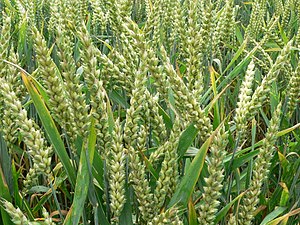National
yields are estimated at 12 percent below the five year average and a high proportion
of wheat has a specific weight below 65 kg/hl. Not only are some producers
facing problems trying to sell their crop, traders are being forced to think creatively
about how they can fulfil their obligations and get the best returns for
growers, he says.
“We estimate around 75 percent of the wheat crop we’ve traded so far is below
72kg/hl with a large proportion of this in the mid to low 60's. To put this
into perspective, the average for the previous three years was 77.5kg/hl.
There
was a lot of confusion at harvest with many merchants unable to deal with the
lower quality wheat and if anything, the situation has got worse during the
autumn.
 |
| English: Wheat (Triticum aestivum) near Auvers-sur-Oise, France, June 2007 (Photo credit: Wikipedia) |
“The export market has been trading at a significant discount to the UK
domestic market and as such the most commercial approach would have been for us
to cash settle all of our exports sales and allocate all our grain to the
domestic market. This is in fact what a lot of other merchants have done but as
a result they have been struggling to place anything below 65 kg/hl.
“Our approach has been to try and keep shipping through liaising with our offices in Rotterdam and
Spain and
using the resources we have in the UK to supply overseas customers with an acceptable standard of
wheat and give our
growers an outlet for low specific weights.”
With
the Nidera blending scheme, suppliers of high quality wheat are paid a premium
and their material is blended at the company’s Ipswich Grain Terminal with the
lower specification wheats.
To
meet Nidera’s contractual obligations with its customers a consistent 72kg/hl
has to be made on feed wheat cargoes, Stuart Shiells explains.
“It’s taken a lot of thought as to how we can best use our resources to
deliver the required specification to our customers and provide farmers with an outlet for wheat where others have struggled to
find a solution.
“We’ve
had to work very hard to achieve the required consistency and from our own commercial point of view, it’s not the
most efficient way of doing things. The blending process is costly and kilogram
for kilogram, better quality wheat is far more expensive than the value
recouped through the fallback scale, but it has given producers have a safe outlet for their grain
without the threat of costly rejections and we’ve managed to keep a valuable
export programme going.
Edwin
Cross of Riverfen Farms Ltd in Ely, Cambridgeshire, has put over 1000 tonnes of
wheat into the Nidera programme.
“We
would normally aim to grow around 60% of our wheat for milling and the rest as
feed, but a lot of our crop just hasn’t made the milling premium this year and
the highest specific weight we have achieved is 70 kg/hl with the lowest being
around 60-61kg/hl. We would normally average between 72 – 75 kg/hl,” he
explains.
“Our
view was we wanted to move it off the farm quickly and get a fair price and
that’s exactly what we’ve been able to do with the Nidera scheme.”



No comments:
Post a Comment